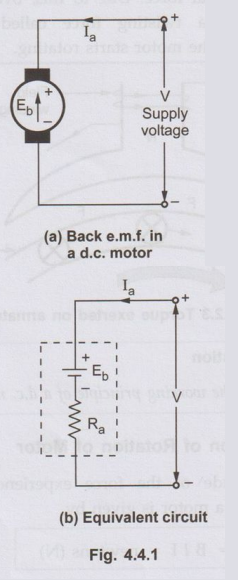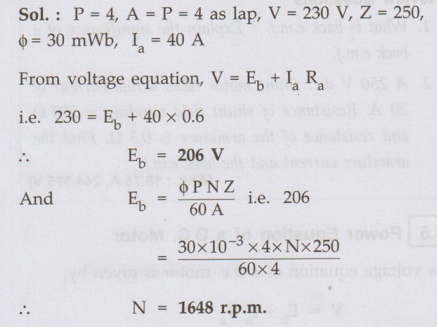Electrical Machines: Unit III: a. D.C. Motors
Significance of Back E.M.F.
DC Motors
It is seen in the generating action, that when a conductor cuts the lines of flux, e.m.f. gets induced in the conductor. The question is obvious that in a d.c. motor, after a motoring action, armature starts rotating and armature conductors cut the main flux. So is there a generating action existing in a motor? The answer to this question is 'Yes'.
Significance
of Back E.M.F.
• It is seen in
the generating action, that when a conductor cuts the lines of flux, e.m.f.
gets induced in the conductor. The question is obvious that in a d.c. motor, after
a motoring action, armature starts rotating and armature conductors cut the
main flux. So is there a generating action existing in a motor? The answer to
this question is 'Yes'.
•
After a motoring action, there exists a generating action. There is an induced
e.m.f. in the rotating armature conductors according to Faraday's law of
electromagnetic induction. This induced e.m.f. in the armature always acts in
the opposite direction of the supply voltage. This is according to the Lenz's
law which states that the direction of the induced e.m.f. is always so as to
oppose the cause producing it. In a d.c. motor, electrical input i.e. the
supply voltage is the cause and hence this induced e.m.f. opposes the supply voltage. This e.m.f. tries
to set up a current through the armature which is in the opposite direction to
that, which supply voltage is forcing through the conductor.
•
So as this e.m.f. always opposes the supply voltage, it is called back e.m.f.
and denoted as Eb. Though it is denoted as Eb, basically
it gets generated by the generating action which we have seen earlier in case
of generators. So its magnitude can be determined by the e.m.f. equation which
is derived earlier. So, Eb = ΦΡΝΖ
/ 60 A volts
where
all symbols carry the same meaning as seen earlier.
•. This e.m.f. is
shown schematically in the Fig. 4.4.1 (a). So if V is supply voltage in volts
and R is the value of the armature resistance, the equivalent electric circuit
can be shown as in the Fig. 4.4.1 (b).

1. Voltage Equation of a D.C. Motor
•
In case of a generator, generated e.m.f. has to supply armature resistance drop
and remaining part is available across the load as a terminal voltage. But in
case of d.c. motor, supply voltage V has to overcome back e.m.f. Eb,
which is opposing V and also various drops as armature resistance drop Ia
Ra brush drop etc. Infact the electrical work done in overcoming the
back e.m.f. gets converted into the mechanical energy developed in the
armature. Hence the voltage equation of a d.c. motor can be written as,
V
= Eb + Ia Ra + Brush drop
Neglecting
the brush drop, the generalized voltage equation is,
V
= Eb+IaRa
The
back e.m.f. is always less than supply voltage (Eb < V). But Ra
is very small hence under normal running conditions, the difference between
back e.m.f. and supply voltage is very small. The net voltage across the
armature is the difference between the supply voltage and back e.m.f. which
decides the armature current. Hence from the voltage equation we can write,
Ia
= V-Eb / Ra
Key Point:
Voltage equation gets changed a little bit depending upon the type of the
motor, which is discussed later.
Ex. 4.4.1
A 220 V, d.c. motor has an armature
resistance of 0.75Ω. It is drawing an armature current of 30 A, driving a
certain load. Calculate the induced e.m.f. in the motor under this condition.
Sol. : V
= 200 V, Ia = 30 A, Ra = 0.75 Ω are the given values
For
a motor, V = Eb + Ia Ra
i.e.220
= Eb + 30 x 0.75
Eb
= 197.5 volts
This
is the induced e.m.f. called back e.m.f. in a motor.
Ex. 4.4.2 A 4 pole, d.c. motor has lap
connected armature winding. The flux per pole is 30 mWb. The number of armature
conductors is 250. When connected to 230 V d.c. supply it draws an armature
current of 40 A. Calculate the back e.m.f. and the speed with which motor is
running. Assume armature resistance is 0.6 Ω.
Sol.

2. Back E.M.F. as a Regulating Mechanism
•
Due to the presence of back e.m.f. the d.c. motor becomes a regulating machine
i.e. motor adjusts itself to draw the armature current just enough to satisfy
the load demand. The basic principle of this fact is that the back e.m.f. is
proportional to speed, Eb ∞ N.
•
When load is suddenly put onto the
motor, motor tries to slow down. So speed of the motor reduces due to which
back e.m.f. also decreases. So the net voltage across the armature (V - Eb)
increases and motor draws more armature current. As F = B l I, due to increased
current, force experienced by the conductors and hence the torque on the
armature increases. The increase in the torque is just sufficient to satisfy
increased load demand. The motor speed stops decreasing when the armature
current is just enough to produce torque demanded by the new load.
•
When load on the motor is decreased, the speed of the motor tries to increase.
Hence back e.m.f. increases. This causes (V - Eb) to reduce which
eventually reduces the current drawn by the armature. The motor speed stops
increasing when the armature current is just enough to produce the less torque
required by the new load.
Key Point:
So back e.m.f. regulates the flow of armature current and it automatically
alters the armature current to meet the load requirement. This is the practical
significance of the back e.m.f.
Review Questions
1. What is back
e.m.f.? Explain the significance of a back e.m.f.
2. A 250 V d.c. shunt
motor takes a line current of 20 A. Resistance of shunt field winding is 200 Ω
and resistance of the armature is 0.3 Ω. Find the armature current and the back
e.m.f. Ans. 18.75 A, 244.375 V)
Electrical Machines: Unit III: a. D.C. Motors : Tag: : DC Motors - Significance of Back E.M.F.
Related Topics
Related Subjects
Electrical Machines I
EE3303 EM 1 3rd Semester EEE Dept | 2021 Regulation | 3rd Semester EEE Dept 2021 Regulation
